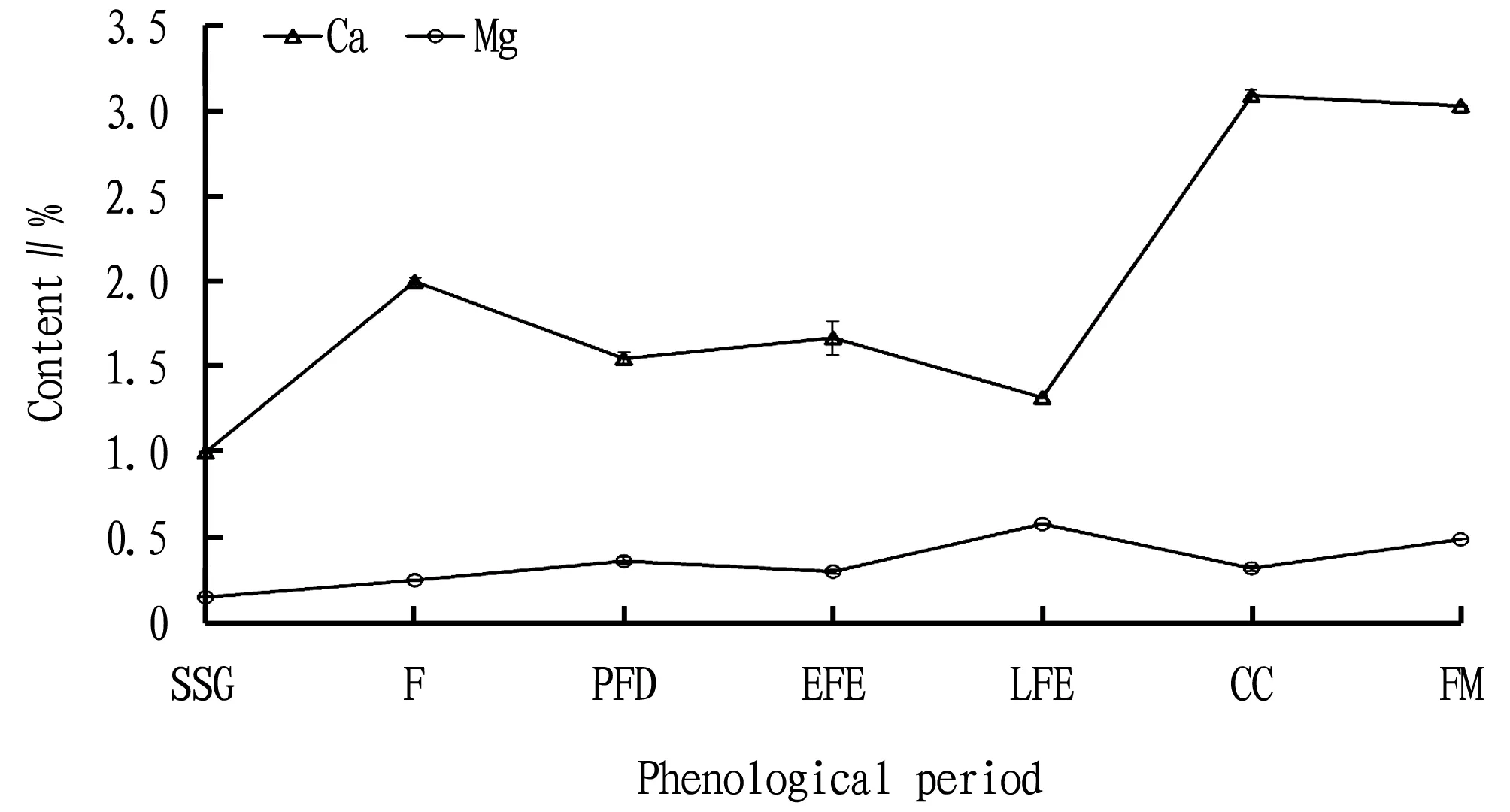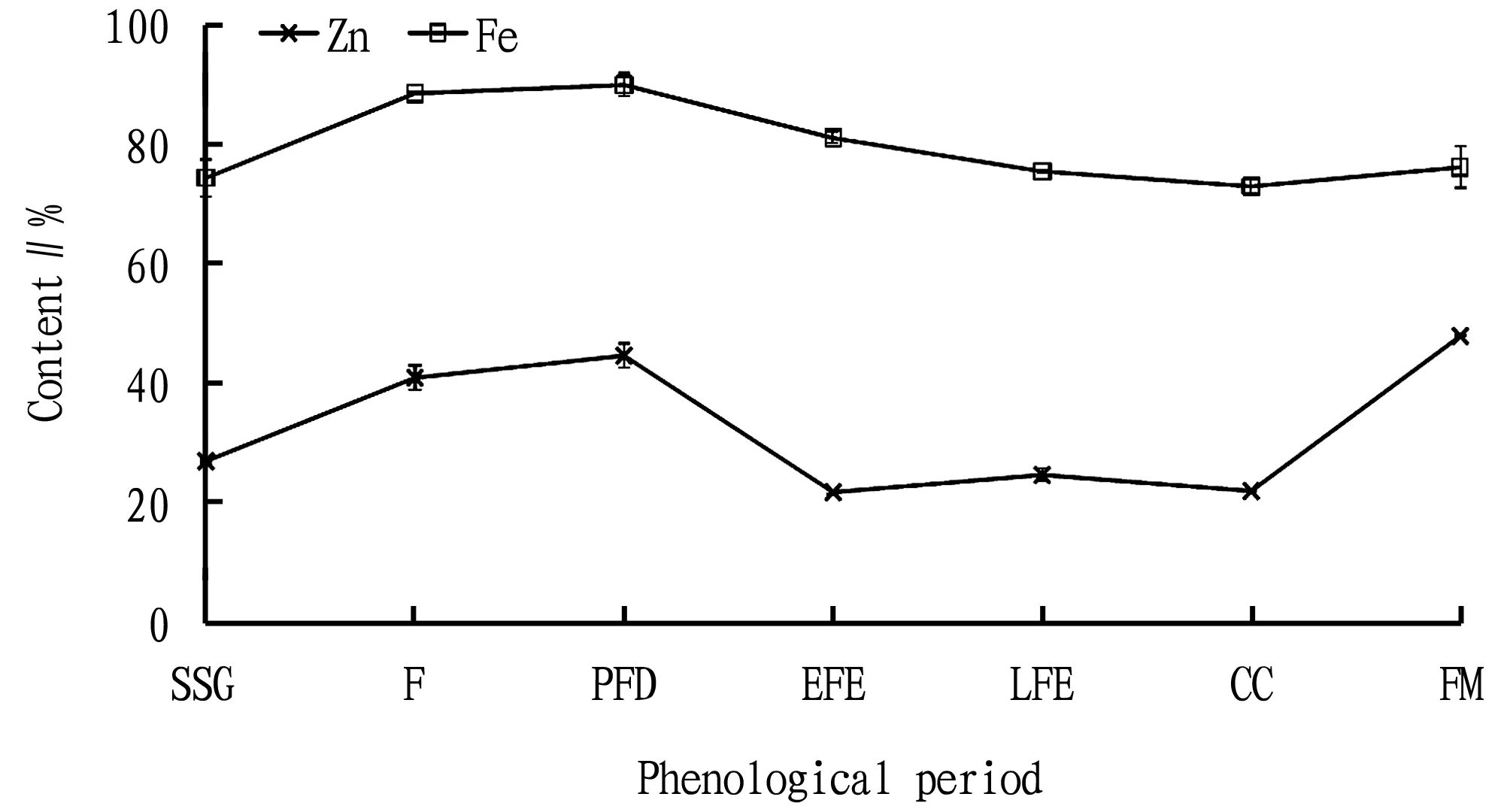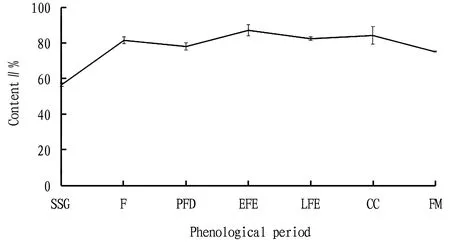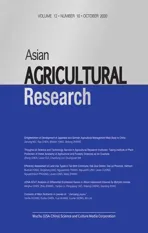Contents of Main Nutrients in Leaves of ‘Jianyang Juyou’
2020-11-30YanfeiHUANGGuifenCHENYuyiHUANGLiumeiXIONGBinLIU
Yanfei HUANG, Guifen CHEN, Yuyi HUANG, Liumei XIONG, Bin LIU
Agricultural Resources and Environment Research Institute, Guangxi Academy of Agricultura Sciences, Nanning 530007, China
Abstract [Objectives] This study aimed to understand and master the nutritional characteristics of ‘Jianyang Juyou’ growing in southern Guangxi, with a view to providing a theoretical basis for the rational fertilization of local orchards. [Methods] The leaves of 3-year-old ‘Jianyang Juyou’ were sampled according to the phenological characteristics, and the dynamics in the contents of macronutrients and main trace elements N, P, K, Ca, Mg, Fe, Zn and B in the leaves were analyzed. [Results] The average contents of N, P and K in the leaves of ‘Jianyang Juyou’ were in the order as N>K>P. Among them, the content of N reached the highest during the flowering period and then decreased; K maintained a high content around the fruit enlargement period; the Ca content of leaves is significantly greater than that of Mg, and the peak value of Ca content appeared during the flowering and color change periods; the Mg content increased from the germination stage to the late fruit enlargement stage, while decreased in the color change stage; the average contents of main trace elements in the leaves ranked as Fe>B>Zn; the Fe content gradually increased from the germination stage to the physiological fruit drop stage, and slowly decreased after the fruit enlargement; the Zn content peaked in the physiological fruit drop period and fruit maturity period; and the B content of the leaves was 81.6-87.2 mg/kg during the flowering period, the early period of fruit enlargement, the late period of fruit enlargement, and the color change period. [Conclusions] During the phenological period, the leaves of ‘Jianyang Juyou’ had a higher demand for N, and the peak absorption period was mainly concentrated from the germination period to the early period of fruit enlargement; the demand for K was second only to N, and the peak absorption period was concentrated in the early stage of fruit enlargement to the mature stage; and the demand for P was minimal. In the production of ‘Jianyang Juyou’ Mg played an important role in promoting budding and blooming, preserving flowers and fruits and promoting fruit enlargement, so attention should be paid to the application of Mg fertilizer before the color change period. During the flowering period, the early period of fruit enlargement, the late period of fruit enlargement, and the color change period, B fertilizer could be appropriately increased by soil application or foliar spraying. Due to the large fluctuation of Zn content in leaves and small mobility of Zn, it could be supplemented quickly by spraying on the leaf surface before the physiological fruit drop period and fruit maturity period.
Key words Jianyang Juyou, Leaf, Macronutrient, Trace element
1 Introduction
‘Jianyang Juyou’ is a variety bred from bud mutation of Tianchun tangelo[1], characterized with strong tree vigor, fast growth of young trees, strong resistance, high surface content in the flesh, tenderness, good quality and tolerance to storage and transportation. Generally, a single fruit weighs up to 300 g, and the output can reach 88 000 kg/ha[2]. It is currently one of the varieties with excellent comprehensive traits in hybrid oranges[3]. For good economic benefits, ‘Jianyang Juyou’ has been introduced to Guangxi for planting in recent years, and the planting area is gradually expanding. The planting of ‘Jianyang Juyou’ in some mountainous areas of Guangxi has become a pillar industry for farmers to increase their incomes[4]. As a newly introduced tangelo variety, the nutrient requirements of ‘Jianyang Juyou’ are still unclear. Applying fertilization according to ordinary citrus management methods will inevitably cause problems such as imbalanced nutrient supply, low fertilizer utilization and low output efficiency[5]. The leaves are the "source" organ that produces, accumulates and stores nutrients. To a certain extent, leaf nutrient changes can reflect the nutritional status of fruit trees[6]. Studies have shown that leaf nutrition can directly reflect the nutrient supply of citrus trees and soil[7-8]. Therefore, understanding the nutrient changes of citrus leaves is of great significance for scientifically guiding citrus orchards to fertilize. In recent years, studies on leaf nutrient elements such as navel orange, Shatian pomelo and Wenzhou mandarin have been reported[9-12]. The research of ‘Jianyang Juyou’ is mainly focused on the evaluation of variety characteristics, pest control and other aspects[13]. However, there are few reports on the relevant research on the nutritional characteristics of ‘Jianyang Juyou’ leaves. In this study, taking 3-year-old ‘Jianyang Juyou’ as the experimental material, the leaves were sampled according to the characteristics of the phenological period, and the dynamics of the contents of macronutrients and main trace elements in the leaves were analyzed, to understand and master the nutritional characteristics of ‘Jianyang Juyou’ growing in southern Guangxi, and provide a theoretical basis for the rational fertilization of local orchards.
2 Materials and methods
2.1 MaterialsThe plant material was three-year-old ‘Jianyang Juyou’ growing in an orchard in the demonstration base of Jialuguang Agriculture Co., Ltd. in Nawen Village, Nalou Town, Yongning District, Nanning City, Guangxi. The area where the orchard is located has a subtropical monsoon climate, with monthly average temperature of 18-28 ℃, annual rainfall of 1 300 mm and average relative humidity of 80%. The pH of the soil was 4.93, and the contents of organic matter, alkali-hydrolyzable nitrogen, available phosphorus, available potassium, exchangeable Ca, exchangeable Mg, available Fe, available Zn and available B in the soil were 11.94, 86.13, 5.87, 94.47, 1.76, 0.48, 18.92, 0.63 and 0.28 mg/kg, respectively. Conventional management was performed. The phenological period in Nanning, Guangxi is as follows: from the end of February to March 12, the spring shoots are sprouting; from March 12 to April 15, flowering period; from April 15 to May 20, physiological fruit drop period; from May 20 to late October, fruit enlargement period; from early November to early December, color change period; and mid-December, fruit ripening period.
2.2 Sampling methodIn 2019, in the orchard of the demonstration base of Jialuguang Agriculture Co., Ltd. in Nalou Town, Yongning District, Nanning, 15 normal ‘Jianyang Juyou’ plants with basically the same growth were selected as fixed sampling trees. During the germination period (March 5), the flowering period (April 3), the physiological fruit drop period (May 5), the early period of fruit enlargement (July 5), the late period of fruit enlargement (October 12), the color change period (November 25) and the fruit ripening period (December 17), 20 leaves (the fourth leaf from the top of the vegetative branch of the spring shoot of the current year, 1.5-2.0 m above the ground) were sampled from the eastern, southern, western, northern and central parts of the canopy of each tree, respectively[11]. The leaves collected were taken back to the laboratory. They were wiped with a clean wet towel, put in envelopes and sealed, dried at 90 ℃ for 30 min and at 70 ℃ to constant weight, crushed, and passed through 1 mm sieve successively.
2.3 Analysis method of leaf nutrient contentThe contents of total nitrogen, total phosphorus and total potassium were determined with reference to NY/T2017-2011. The content of total nitrogen was determined by Kjeldahl method; the content of total potassium is determined by flame atomic absorption spectrophotometry, and the content of total phosphorus was determined by the molybdenum antimony anticolorimetry. The contents of Ca, Mg, Fe and Zn in leaves were determined referring to NY/T1270-1999. The samples were digested with nitric acid-perchloric acid and determined by atomic absorption spectrophotometry. The content of total boron was determined by dry ashing-azomethine colorimetric method.
2.4 Data processingData statistics and processing was performed using Excel 2016. Data analysis was completed by using SPSS 19.0. Charts and tables were made using Excel 2016.
3 Results and analysis
3.1 Dynamics of N, P and K contents in ‘Jianyang Juyou’ leavesAs shown in Fig.1, the contents of N, P and K in ‘Jianyang Juyou’ were in the order as N>K>P. The N content of leaves in the phenological period ranged from 1.39% to 3.65%, with an average of 2.65%. It reached the highest (3.65%) in the flowering period and then decreased gradually with the proceeding of the growth. Although it increased slightly in the color change period, and decreased to the lowest (1.39%) in the fruit ripening period. The P content of the leaves was 0.13%-0.40%, with a mean of 0.21%. From the germination period to late fruit enlargement period, the range of changes was small; after entering the fruit color change period, it increased gradually; and the P content reached the peak (0.40%) in the fruit ripening period. The K content of the leaves was in the range of 1.60%-2.76%, with a mean of 2.00%. During the phenological period, it decreased gradually from the germination period to the physiological fruit drop period, increased rapidly in the fruit enlargement period, declined from the late fruit enlargement period to the color change period, and increased rapidly in the fruit ripening period. It indicates that in the phenological period, ‘Jianyang Juyou’ had a higher demand for N, and the peak absorption period was mainly concentrated from the germination period to the early period of fruit enlargement; the demand for K was second only to N, and the peak absorption period was concentrated from the early stage of fruit enlargement to the fruit ripening period; and its demand for P was minimal.

Note: SSG period: spring shoot germination period; F period: flowering period; PFD period: physiological fruit drop period; EFE period: early fruit enlargement period; LFE period: late fruit enlargement period; CC period: color change period; FM period: fruit maturity period. The same in Fig.2-4.Fig.1 Dynamics of N, P and K contents in the leaves of ‘Jianyang Juyou’ in the growth period
3.2 Dynamics of Ca and Mg contents in ‘Jianyang Juyou’ leavesIn the phenological period, the average Ca content of leaves was 1.95%, which was significantly greater than the average Mg content of 0.35%. The leaf Ca content appeared at the first peak of 2.00% during the flowering period, decreased gradually after the flowering period, reached the lowest value of 1.32% in the late fruit enlargement period, rose to 3.09% rapidly in the color change period, and decreased gradually in the fruit ripening period. The leaf Mg content increased rapidly from the germination period to the late fruit enlargement period, then peaked (0.58%), declined in the color change period, and increased in the fruit ripening period (Fig.2).

Fig.2 Dynamics of Ca and Mg contents in the leaves of ‘Jianyang Juyou’ in the growth period
3.3 Dynamics of Fe and Zn contents in ‘Jianyang Juyou’ leavesIn the phenological period, the average Fe content in the leaves was 79.9 mg/g, and the average Zn content was 32.7 mg/kg. The Fe content of the leaves gradually increased from the spring shoot germination stage to the physiological fruit drop stage. After the physiological fruit drop period, it slowly decreased to the minimum value of 73.1 mg/kg in the color change period. After entering the fruit maturity period, it increased again. The Zn content in the leaves increased rapidly from the spring shoot germination period to the physiological fruit drop stage. It decreased rapidly from the physiological fruit drop period to the early period of fruit enlargement, and increased rapidly after the color change period. During the phenological period, the Zn content of leaves showed two peaks of 44.7 and 48.0 mg/kg in the physiological fruit drop stage and fruit maturity period, respectively (Fig.3).

Fig.3 Dynamics of Fe and Zn contents in the leaves of ‘Jianyang Juyou’ in the growth period
3.4 Dynamic of B content in ‘Jianyang Juyou’ leavesThe leaf B content varied greatly during the phenological period (Fig.4), ranging from 56.8 to 87.2 mg/kg, with an average of 78.0 mg/kg. It maintained at a higher level (81.6-87.2 mg/kg) in the flowering stage, early fruit enlargement stage, late fruit enlargement stage and color change stage. In the spring shoot germination period and fruit maturity period, the leaf B contents were 56.8 and 75.2 mg/kg. below the average value (Fig.4).

Fig.4 Dynamic of B content in the leaves of ‘Jianyang Juyou’ in the growth period
4 Discussion and conclusions
Leaf is the main organ for photosynthesis of citrus. It plays an important role in maintaining the normal production and growth of plants, and is also one of the most active organs for nutrient absorption. Generally, the content of macronutrient elements in citrus leaves is higher than that in other organs[14]. The results of this study show that the average contents of N, P and K in the leaves of ‘Jianyang Juyou’ during the phenological period were in the order of N﹥K﹥P, which is similar to the rank of the average contents of N, P and K in the leaves of Wenzhou mandarin and sweet orange[15-16]. However, the absorption of N, P and K nutrients by citrus in different phenological periods is significantly different[9]. The results of this study show that the N content of ‘Jianyang Juyou’ leaves was up to 3.65% during the flowering period, and gradually decreased with the proceeding of the growth period. In the fruit ripening period, it dropped to the lowest value of 1.39%, which is similar to the finding of Liu Xinghuietal.[17]on the changes in the leaf N content of Nanfeng mandarin orange, Sekken and tangerine produced in Fujian Province during the phenological period. The P content of the leaves changed slightly from the germination stage to the late fruit enlargement stage and gradually increased after entering the fruit color change period, which is opposite to the trend of N demand. The K element peaked in the germination period, the early period of fruit enlargement, and the fruit ripening period. It shows that topdressing K fertilizer in the corresponding period will promote the germination and fruit enlargement of trees.
The contents of Ca and Mg in ‘Jianyang Juyou’ leaves showed obvious seasonal fluctuations with the phenological period. The Ca content appeared the first peak in the flowering period. It decreased rapidly after the flowering period. In the color change period, it increased rapidly. The reason might be related to the function of calcium nutrition on the tree. The increase in the content during flowering promoted the formation of flowers and fruit, and the increase in the color change period played an important role in preventing fruit cracking and maintaining quality[18]. Mg is the central element of chlorophyll. It participates in photosynthesis and carbohydrate synthesis, playing an important role in the growth and development of citrus[19]. The results of this study show that during the period from germination to fruit enlargement, the demand for Mg in ‘Jianyang Juyou’ was gradually increased, and in the color change period, it reduced, which is significantly different from the finding of Xiao Jiaxinetal.[20]on the annual change of Mg content in Wenzhou tangerine fruit. It shows that in the production of ‘Jianyang Juyou’, Mg plays an important role in promoting budding, blooming and fruit enlargement. Therefore, attention should be paid to the application of Mg fertilizer before the color change period.
The content of micronutrients in citrus trees is much lower than that of large and medium nutrients, but they have an irreplaceable effect on the yield and quality of citrus[21]. The results of this study show that the average contents of trace elements in ‘Jianyang Juyou’ leaves were Fe﹥B﹥Zn. The Fe content of leaves changed relatively smoothly during the phenological period. It might be related to the relatively abundant available Fe content in the experimental soil and the relatively stable demand for Fe in different phenological periods. The B content of the leaves was maintained at a high level during the flowering period, the early fruit enlargement period, the late fruit enlargement and the color change period. It shows that the demand of ‘Jianyang Juyou’ for B is relatively high during these periods. Therefore, during the flowering period, the early period of fruit enlargement, the late period of fruit enlargement and the color change period, B fertilizer can be appropriately increased by soil application or foliar spraying. The Zn content of leaves fluctuated greatly. As Zn has small mobility, it is recommended to quickly supplement Zn by spraying on the leaf surface before the physiological fruit drop period and fruit ripening period.
杂志排行
Asian Agricultural Research的其它文章
- Application of Robust Strategies in Location Selection of Logistics Distribution Center for Fresh Agricultural Products
- Empirical Study on Impact of China’s Economic Growth on Agricultural Trade
- Efficiency Assessment of Land Use Types in Tan Binh Commune, Dak Doa District, Gia Lai Province, Vietnam
- Some Thoughts on China’s Territorial Spatial Planning in the New Period
- Functional Positioning of Pastoral Complex in the Context of Rural Revitalization Strategy: A Case Study of Pavlo Eco Valley in Gaoan City of Jiangxi Province
- cDNA-SCoT Analysis of Differential Expressed Genes in Allium tuberosum Induced by Botrytis cinerea
